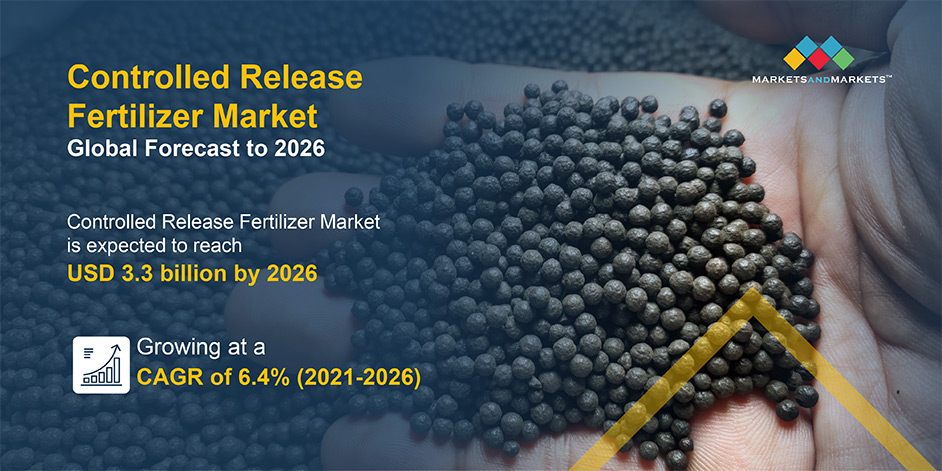The Controlled Release Fertilizer Market is expected to grow from USD 2.4 Billion in 2021 to USD 3.3 Billion by 2026, with a CAGR of 6.4% during the forecast period. The rise in the global population, growing application rates in developing countries, and rising demand for high-value crops are key factors that are projected to drive the growth of the controlled release fertilizer market during the forecast period.

Driver: Necessity for highly efficient fertilizers
Nutrient loss to the environment is one of the major concerns faced by farmers across the world. Heavily fertilized crops such as corn tend to have large losses relative to non-intensive uses such as pasture. Agricultural uses associated with poor land management practices that lead to erosion also produce significant nutrient losses. Nutrient losses can occur in many ways, which can have an extensive impact on the environment.
Atmospheric losses: Nutrients can be lost to the atmosphere through chemical and biological processes, wherein volatile nutrients can be easily lost as gases when exposed to the atmosphere.
Direct loss: Direct or incidental loss is the loss of fertilizer or manure to water before interacting significantly with soil. It can result from over-application, heavy rainfall immediately following application, or application directly into a waterway (including ditches).
Runoff: Runoff occurs when rainfall or snowmelt exceeds the infiltration rate of the soil. Runoff carries away the dissolved nutrients into the nearby water bodies.
Leaching: Leaching is the downward movement of water and soluble substances in the soil below the root zone. It is an environmental concern as it contributes to groundwater contamination.
Nutrient losses into the water trigger eutrophication on the surfaces of water bodies, which in turn ruins the aquatic ecosystem. This concern associated with fertilizers and nutrients used on soil has risen in recent years, owing to which Fertilizer Best Management Practices are promoted by fertilizer industries and associations across the globe, under which enhanced efficiency fertilizers (EEF) are developed, and farmers are encouraged to adopt these fertilizers. These practices are related to the proper use of fertilizers at the right quantity, at the right time, and at the right place. Thus, they are driving the use of controlled release fertilizers in the market.
What are the factors driving the growth of the controlled release fertilizers market?
Controlled Release Fertilizer Market Trends:
- Growing Demand for Precision Agriculture: The controlled release fertilizer market is witnessing a growing demand for precision agriculture, where the application of fertilizer is optimized based on the needs of specific crops, resulting in better yield and reduced fertilizer waste.
- Rise in Adoption of Organic Farming: The increase in the adoption of organic farming practices and the growing demand for organic food products are driving the demand for organic fertilizers, including controlled release fertilizers.
- Increasing Awareness About Soil Health: The increasing awareness about soil health and the need to maintain its fertility is driving the demand for controlled release fertilizers, which help maintain soil fertility over an extended period.
- Rising Demand for Fertilizer Granules: The demand for fertilizer granules, which are easy to handle, store, and transport, is growing in the controlled release fertilizer market.
- Growing Demand from Developing Countries: The increasing demand for food crops in developing countries is driving the demand for controlled release fertilizers, as farmers aim to increase their yields to meet the growing demand for food.
- Technological Advancements in Fertilizer Manufacturing: The increasing adoption of new technologies in fertilizer manufacturing, such as nanotechnology and biotechnology, is driving the demand for controlled release fertilizers.
- Government Support for Fertilizer Use: The increasing support from governments around the world for the use of fertilizers to increase agricultural productivity is driving the demand for controlled release fertilizers.
